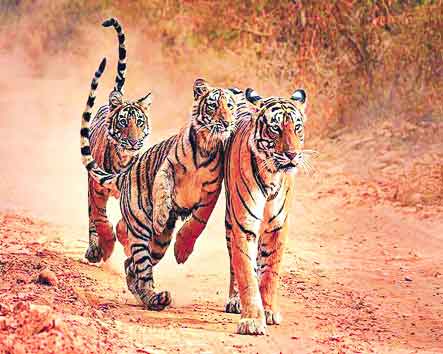Just numbers are not enough now, we need to create stable homes for the growing tiger population
Wildlife lovers can take heart from two new findings over the last few days. The first is that India’s tiger population is set to double by 2022 from the crisis figure of around 1,400 in 2010. The second is of the Pench tigress, Collarwali Baghin, who has had a record-breaking seven litters. Both have been the result of sustained and focussed tiger conservation efforts in mission mode despite funding and infrastructural bottlenecks. India, which has around 70 per cent of the world’s tiger population in the wild, can pat its back a bit, considering that host countries in the neighbourhood like Bangladesh, Cambodia, Thailand, Indonesia, Malaysia and even Vietnam, have not been able to revive and nurture the big cat. The Pench tigress shows that she has a healthy fertility. Experts say seven litters in a lifespan of 12 years are rare and nothing short of a world record as a tigress normally has her first litter at the age of three and waits at least two years before the next one. Besides, her litter has a healthy number of cubs, four in this case. This also points to the tigress’ strength and agility in hunting and rearing her cubs and hand-holding them to adulthood. As Pench Tiger Reserve Field Director Subranjan Sen said, the tigress would need to hunt approximately a cheetal a week till the cubs are about three months old and one or even two cheetals a day later. That would test her endurance. If she manages this feat, it would mean that the Indian tiger has not only survived but emerged stronger courtesy a high prey base and a secure habitat. This is already borne out by the fact that the Pench tigress is the latest among a growing number of tough tigress mothers known for their many litters and cubs, some of whom become equally adept territorially. Of course, we need to remember that Pench, which has healthy prey animals as well as hideouts, is a safe enabler for tiger conservation. Some reserves like Sariska may not be as ideal for breeding.
However, there is a flip side to the increase in tiger population, which exerts pressure on their territoriality within existing habitats. In fact, 22 per cent of our big cats have already strayed out of their reserves and found themselves victims of man-animal conflict. Last year, half of the tiger deaths were outside reserves, caused by human intervention, either by way of poaching or poisoning. The next stage of the conservation story should now focus on habitat protection, equalising tiger density and meeting challenges of translocating those who need a bigger area for survival. The National Tiger Control Authority (NTCA) is assiduously working on developing prey bases in other reserves to minimise tigers straying into buffer villages. Then there is the issue of fragmented forest corridors. The tiger is a roamer and can cover long ranges for survival but natural transit corridors connecting forests are vanishing fast due to human encroachment and development. Unused to being hemmed in from all sides, the tiger is hitting out with desperate aggression when prodded by human intervention. Though there are still viable tracts of pristine forests that can be turned into reserves by relocating animals from overpopulated stretches, fact is forests are a state subject and an inter-state agreement on shared corridors needs to be ironed out and coordinated if translocation is to succeed. To avoid tiger deaths on railway lines, bypasses, whether over or under passes, can be created around existing cross-sections. Finally, we need to make buffer villagers stakeholders in conservation efforts, keeping them invested as park patrollers and monitors, generating a subsidiary tiger economy that ensures them revenue, incentivising forest produce and enhancing the tiger gene pool that can promote “sighting tourism.” Just numbers are not enough now, we need to create stable and sustainable homes for new cubs.


























